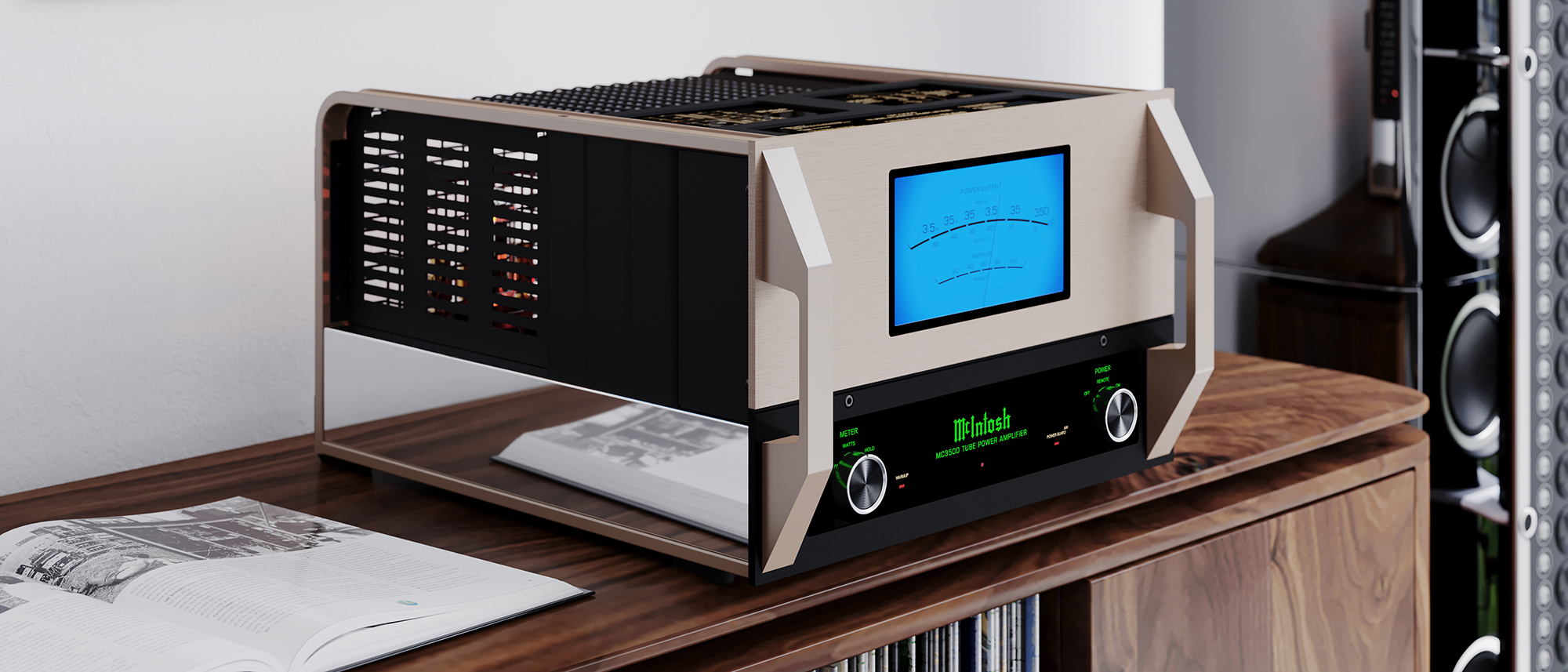What Hi-Fi? Verdict
Listen to this McIntosh system and you’ll discover that you are listening to music – pure, simple, unadulterated music
Pros
- +
Pleasingly natural sounding
- +
Hugely transparent and musical
- +
Enjoyable user experience
Cons
- -
All-analogue; no digital connections or network capability
Why you can trust What Hi-Fi?

This review and test originally appeared in Australian Hi-Fi magazine, one of What Hi-Fi?’s sister titles from Down Under. Click here for more information about Australian Hi-Fi, including links to buy individual digital editions and details on how best to subscribe.
McIntosh built its first amplifier back in 1949, making it one of the longest-running audio brands in the world. Because it started well before the first commercial transistors became available (American physicists John Bardeen, Walter Brattain and William Shockley at Bell Labs had built the first working transistor – for which they were awarded a Nobel Prize in Physics, in 1956 – only two years prior), that first amplifier necessarily used thermionic valves (aka electron tubes) as its amplifying devices.
McIntosh has been building valve amplifiers ever since, though it did also start building transistor (solid-state) amps in 1967 and today builds both solid-state and also ‘hybrid’ amps, which employ both valves and solid-state design.
Given its proven expertise in both valve and solid-state technologies, it should not come as too much of a surprise to learn that the McIntosh C12000ST preamplifier that is one of the four components reviewed here (the others being the C12000C controller and two MC3500 MkII mono power amplifiers) can operate either as a valve amp or a solid-state amp. Choosing which type you’d like to listen to is as simple as flicking a switch. According to McIntosh’s engineering team, your decision as to which to use will depend on the music being played, the audio components in the rest of your system, and your personal preferences regarding sound quality.
If you choose to use the valve option, the line-level amplification is accomplished using two 12AT7 valves and one 12AX7A valve per channel, for a total of six. If you choose to use solid-state line-level amplification, output is via a discrete balanced operational amplifier. No matter what configuration you use, the signals from your phono cartridge will be initially amplified (and RIAA equalised) by four 12AX7A valves (two per channel in a fully balanced configuration).
As for the MC3500 MkII mono power amplifier, its design is a homage to one of the most famous amps of all time, the original McIntosh MC3500, dozens of which were used to power the sound system at the most famous music festival of them all: 1969’s Woodstock. When it came time to celebrate McIntosh’s 50th anniversary, McIntosh President Charlie Randall decided his company should build a MkII version “that takes its inspiration from the original 1968–71 MC3500, and incorporates everything we have learned about vacuum tube amplifier design since the 1960s.”
Interestingly, when audio engineer Owsley Stanley built his famous ‘Wall of Sound’ stage system for the Grateful Dead, he mostly used McIntosh MC-2300 amps… 48 of them!
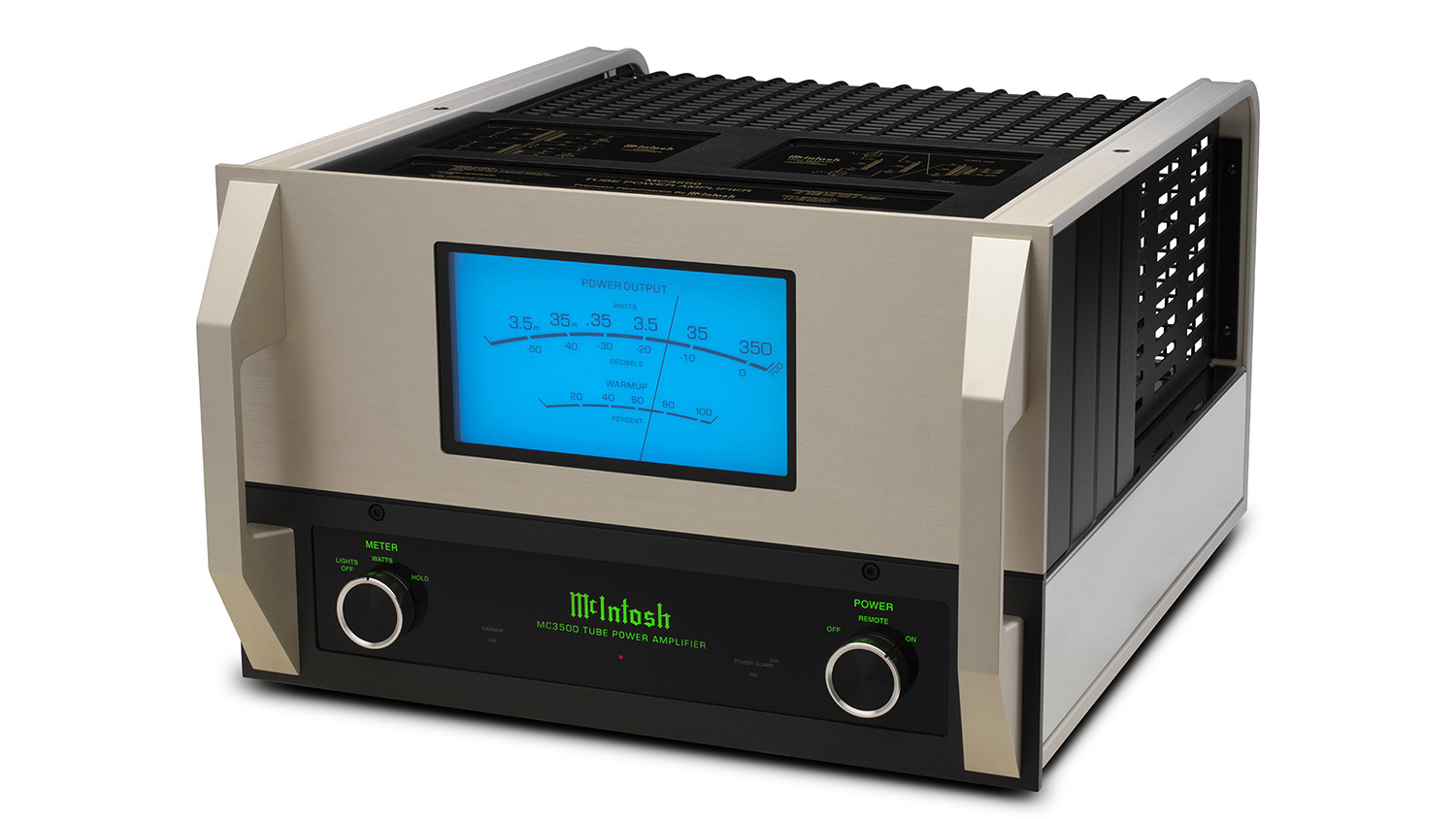
C12000ST preamplifier & C12000C controller
As you’ve no doubt gathered from the photos of it on these pages, the C12000 preamp/controller is not one single integrated unit but two completely physically separate components. The controller (C12000C) does exactly what you’d imagine given its name – it manages the signal path routing, input and output signal switching, volume control, format implementation, and so on. It’s essentially the ‘brains’ of the duo.
The latest hi-fi, home cinema and tech news, reviews, buying advice and deals, direct to your inbox.
The preamplifier (C12000ST), meanwhile, is the device that does the actual amplification of the audio signal – at least up to the point where it’s able to send it on to (in the configuration supplied for this review) the two MC3500 MkII
power amplifiers – although, curiously enough, all signal connections are made on its rear panel, rather than on the rear panel of the C12000 controller as you might otherwise have expected. This means that the two units need to be linked
in some way, something that McIntosh achieves by using two multi-core umbilical cables.
As you can see, there are no controls on the C12000 preamplifier at all, so despite being two completely separate units, the two work as if they were a single unit. Internally, it’s complicated as well, because both are fully dual-mono devices with completely independent power supplies.
Up to 12 analogue sources can be connected to the rear of the C12000 – six of them via balanced inputs, and the other six via unbalanced inputs. Of the latter, two are reserved as phono inputs, each of which can be configured either as a moving-coil or a moving-magnet input, and both of which can have different settings for capacitance, resistance and gain. (Resistance loads are selectable between 25 ohm and 47k omh; capacitance loads between 50 and 400pF.)
We’ve already mentioned that you can switch between having the final amplification stage managed by valves or solid-state devices, but if you look on the rear panel of the C12000 you’ll see four outputs: a balanced valve output, a balanced solid-state, a fixed unbalanced, and a programmable unbalanced that can be either vacuum tube or solid-state. So you have a veritable smorgasbord of output options on offer.
There’s one other output we haven’t so far mentioned, which is the headphone output on the front panel. It’s driven by a ‘High Drive’ circuit that is not only high-powered but also has cross-feed circuitry that optionally ‘bleeds’ right channel signals into the left channel – and vice versa – to make your headphone listening experience more like listening to loudspeakers. McIntosh calls this a ‘Headphone Crossfeed Director Circuitry’ which it identifies by means of the registered trademark ‘HXD’. The description of what this circuit does (in McIntosh’s own words) is that it “restores the directionality component of the spatial sound stage normally heard with loudspeaker listening”.
The McIntosh C12000 certainly has more analogue inputs than you’ll likely ever need, but what it does not have are any digital inputs, nor any ability to connect to the internet via Ethernet. It’s an all-analogue component. This means that you’ll need to do digital-to-analogue conversion externally if you want to play from a CD, SACD, DVD or a streaming device. We’re all in favour of this approach because digital technologies are changing all the time, so if the C12000 did have digital inputs, it’s very likely it would not be long before they might be an ‘old’ (and very possibly even obsolete) technology. Doing it this way effectively makes the McIntosh a ‘forever’ addition to your home entertainment system.
The infra-red remote control supplied with the McIntosh C12000 is so long that one of the review team suggested it could be used to press the various buttons on the front panel from one’s listening position. It was a joke, of course... the remote isn’t quite that long, but at almost a foot it’s certainly the longest remote any of us here at Australian Hi-Fi could ever recall handling. As you’d expect, it not only controls the C12000 but also a number of McIntosh’s other products.
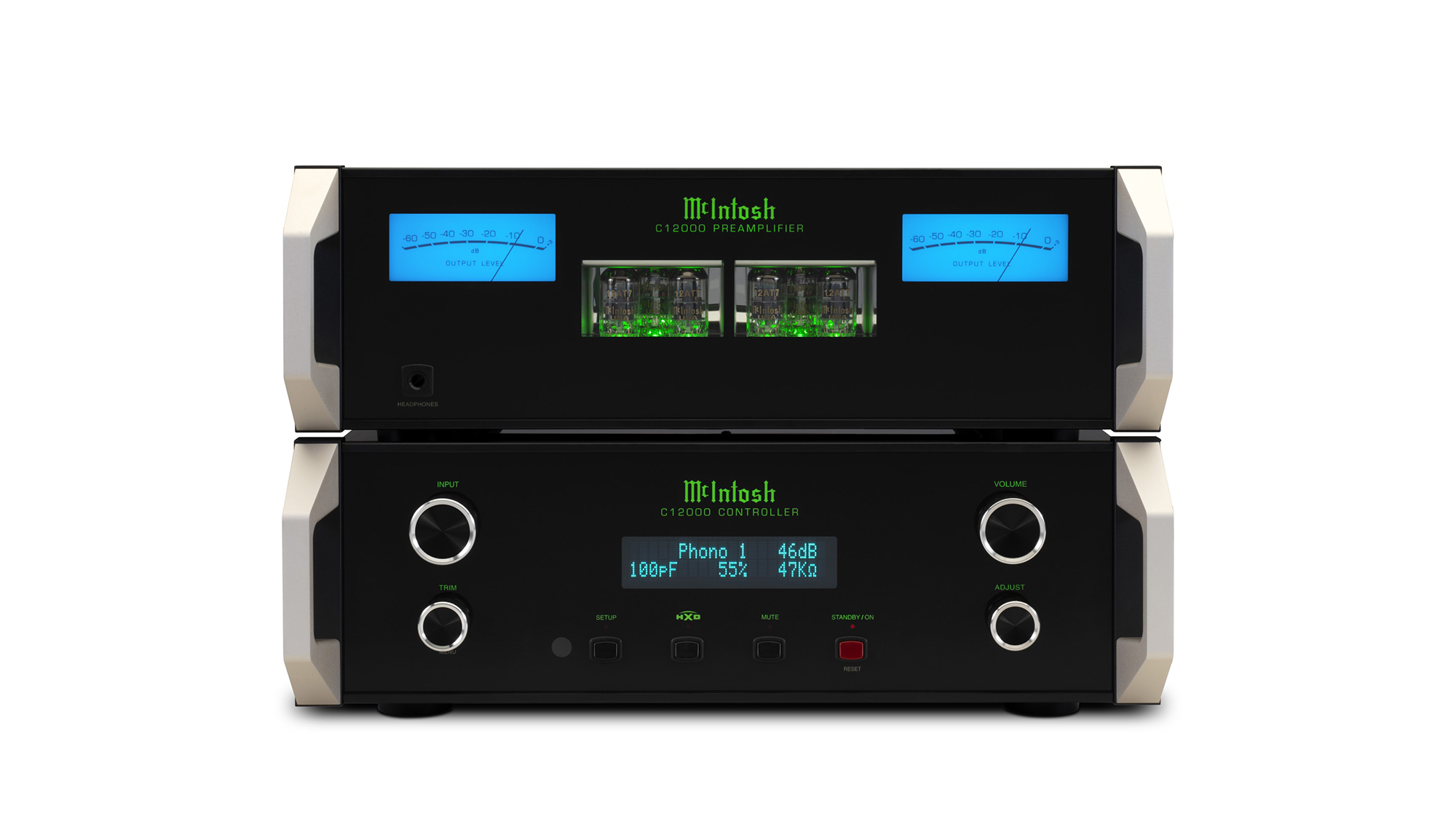
MC3500 MKII mono power amplifier
Since they’re the most obvious fixture on the front panels of the MC3500 MkII mono power amplifiers, we were rather dismayed to find that the power output meters on the two different amplifiers were different colours. The meter on one of our two review amplifiers was the familiar McIntosh blue – and exactly the same shade of blue as those on the C12000 – whereas the meter on the other of our review amplifiers was a much lighter shade of blue, to the point of being an almost ‘greeny-blue’.
In a phone conversation with Australia’s McIntosh distributor, Synergy Audio Visual, it transpired that the colour of McIntosh’s displays is adjustable because the company has varied the shade of the blue it uses quite a bit over the years, so that it only ‘rough-sets’ the shade at the factory. The local distributor is expected to fine-tune the colour to exactly match the display colour of any other McIntosh components the buyer might own, particularly if it’s one of the company’s older models, which used ordinary light bulbs for illumination (all the new models use LEDs, which have a different colour profile). Apparently the MC3500 MkIIs we received were rushed direct to us in order to meet the deadline and had therefore not been through Synergy’s usual set-up procedure, which would have immediately rectified the colour issue.
This colour adjustment is a task for a technician – you can’t do it yourself. The only control the end-user has over the meters is the ability to turn the blue light off completely, and to switch the ballistics of the meter from ‘Watts’ to ‘Hold’. In the Watts mode, the needle dances around showing output power from 3.5 milliwatts (–50dB) to 350 watts (0dB), whilst in the Hold mode the needle shows the most recent highest power output. In this mode, the needle is mostly so motionless that it becomes downright boring to watch. The Watts mode is so much more fun!
If you look at images of the MC3500 MkII, you might guess from the lower scale (which is gradated from 0 to 100 per cent) that the meter also shows power output in per cent. If so, you’d be wrong; this scale is designed to show the amplifier’s warm-up time.
The output valves – all eight of them! – that McIntosh uses in the MC3500 are EL509S beam pentodes, a valve that is a modified version of the original EL509 that has no top plate-cap and an 8-pin octal base. In this design they not only deliver an audio output of 350 watts into any 2-ohm, 4-ohm or 8-ohm load, but also output an incredible amount of thermal energy. We didn’t actually measure the temperature above the amp, but in an air-conditioned room, we became noticeably warmer the closer we moved to either of the two amplifiers. Because of this, we’d suggest keeping them well apart (preferably close to the speakers they’re powering) and not using the supplied valve cages.
McIntosh says it chose this particular valve type because of its similar characteristics and qualities to “the 6LQ6 sweep tubes used on the original MC3500”. The 6LQ6 was also a beam pentode, but the reason it was called a ‘sweep tube’ was because it was originally designed not for audio applications but actually for use in the horizontal output circuit of the televisions of the day, all of which used valves. They were a very sensible choice back then because they had good current and voltage ratings as well as good gain. They were also super-reliable, widely available and, because so many were manufactured for use in TVs, also relatively inexpensive (though now that valves are no longer used in TVs, this last benefit is sadly not the case anymore).
The driver section of the MC3500 MkII is more like that of the original MC3500, being fully balanced, using one 12AT7A and three 12AX7A valves. The special output transformers are also inherited from the original MC3500 and use a unique Unity Coupled design, or what inventors Frank McIntosh and Gordon Gow referred to as a “unity coupled balanced differential feed”. McIntosh managed to extend the patents on this transformer design for so long that when they finally extinguished, the transformer was too expensive for anyone who didn’t already have the winding machinery to build them. You can see a great video in which Gow himself explains how it works.
Comprehensive circuit protection for the MC3500 MkII comes via two of McIntosh’s most renowned circuits, its Power Guard Screen Grid Sensor (which monitors the screen grid current in the EL509S valves and, if it becomes excessive, attenuates the input signal to a safe level to keep the vacuum tubes operating at safe levels) and its Sentry Monitor, which monitors output current and shuts the amplifier off if it senses that a set limit has been exceeded.
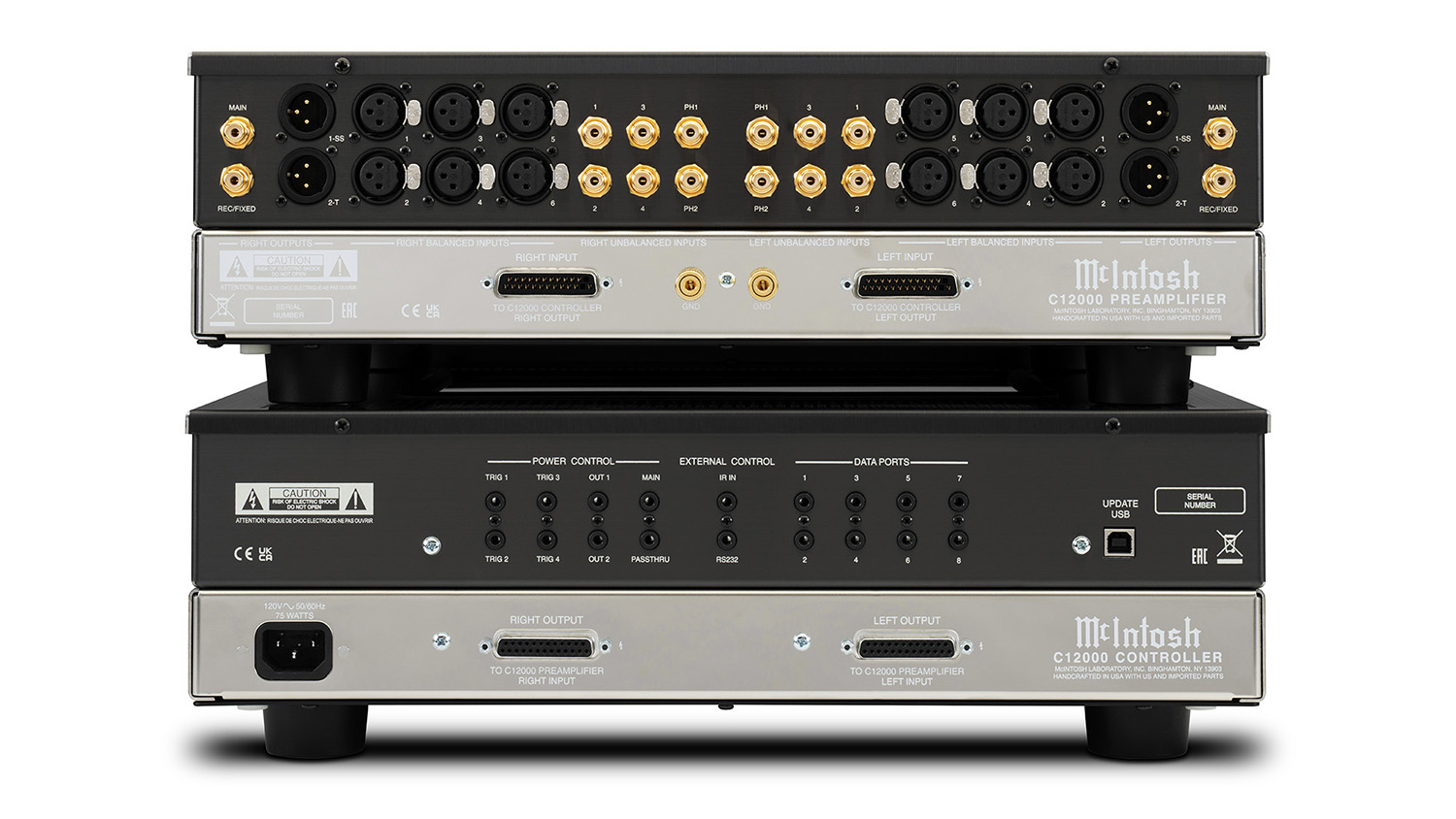
Usability
User interface is an important part of customer satisfaction, and you’ll certainly be totally satisfied with the McIntosh experience. Your primary interaction will undoubtedly be via the volume control, and the one fitted to the C12000 is a beauty! It’s not an ordinary potentiometer but an optical encoder or, to be more precise, a – draws breath – Precision Balanced Digitally Controlled Attenuator System. It delivers 214 individual 0.5dB volume level steps, with 0.1dB tracking accuracy between channels at every one of these 214 levels.
To make your user interface even more satisfying, the rate of volume change is linked to the speed of the control’s rotation, further enhancing that experience. To our minds, the experience would have been even better if the volume control was a weighted flywheel type, but despite this it still felt nice under the fingertips.
Our only initial issue with the volume control is that volume level is displayed as a percentage rather than in dB, but once we became familiar with this slightly unusual concept it made a lot of sense, because identifying the output in per cent relative to the maximum output (or just as some arbitrary number) means that you know exactly how much power is remaining in reserve. So if, for example, you are listening at 10 per cent volume, you know you have 90 per cent of the amplifier’s power still available for transients.
It’s not only the volume control that is unusually implemented; the balance control is rather unconventional as well. Instead of numerals (or percentages!), channel balance is displayed as vertical rows of dots. Balance is centred when you see two vertical rows side by side. If you then rotate the balance control one click to the right, only the rightmost of the two rows will be visible. Click to the right again and two rows will appear, then three, then four and so on. To stop this from being completely unfathomable, McIntosh throws in a space after you get to five rows, so you can more easily identify the next grouping. Ultimately, you can have ten blocks of five vertical rows. It’s certainly an interesting approach to a balance display. We would have preferred a percentage indication!
Switching from one input to any other is done via digitally controlled relays (or as McIntosh prefers to call them, ‘electromagnetic switches’), so switching is totally noiseless. It’s not only noiseless, you can also trim each input to ensure the volume from your speakers (or headphones) stays the same no matter what the output level of the source component you have connected is.
The mute control works exactly as it should, which we mention because it’s so rare to find one that does! By this, we mean that if the C12000 is in its muted mode, it will automatically come out of it if you attempt to adjust the volume control either from the front panel or by using the remote control, and no matter whether you try to adjust it up or down. Although the mute button appears to be a rocker switch, it is actually a spring-loaded press-button (as are the others on the front panel too).
The meters on the C12000 are European sky-blue, which rather contrasts with the back-lighting of the McIntosh logo, which is green and calibrated in dB (not per cent!) from –60dB to +3dB. It’s interesting that the lettering for the +3dB calibration is in a much smaller type than the letters used for the other calibrations. We’re not sure of the reason for this, but we found it looked rather odd. That said, you don’t have to look at the meters at all, since you can switch them off.
You cannot, however, switch any other display items on the front panel off; you can only adjust them between four different levels. Of these four levels, we found the brightest a little too bright and the dimmest a little too dim, but presumably these are able to be adjusted by a technician, just like the colour of the McIntosh meters.
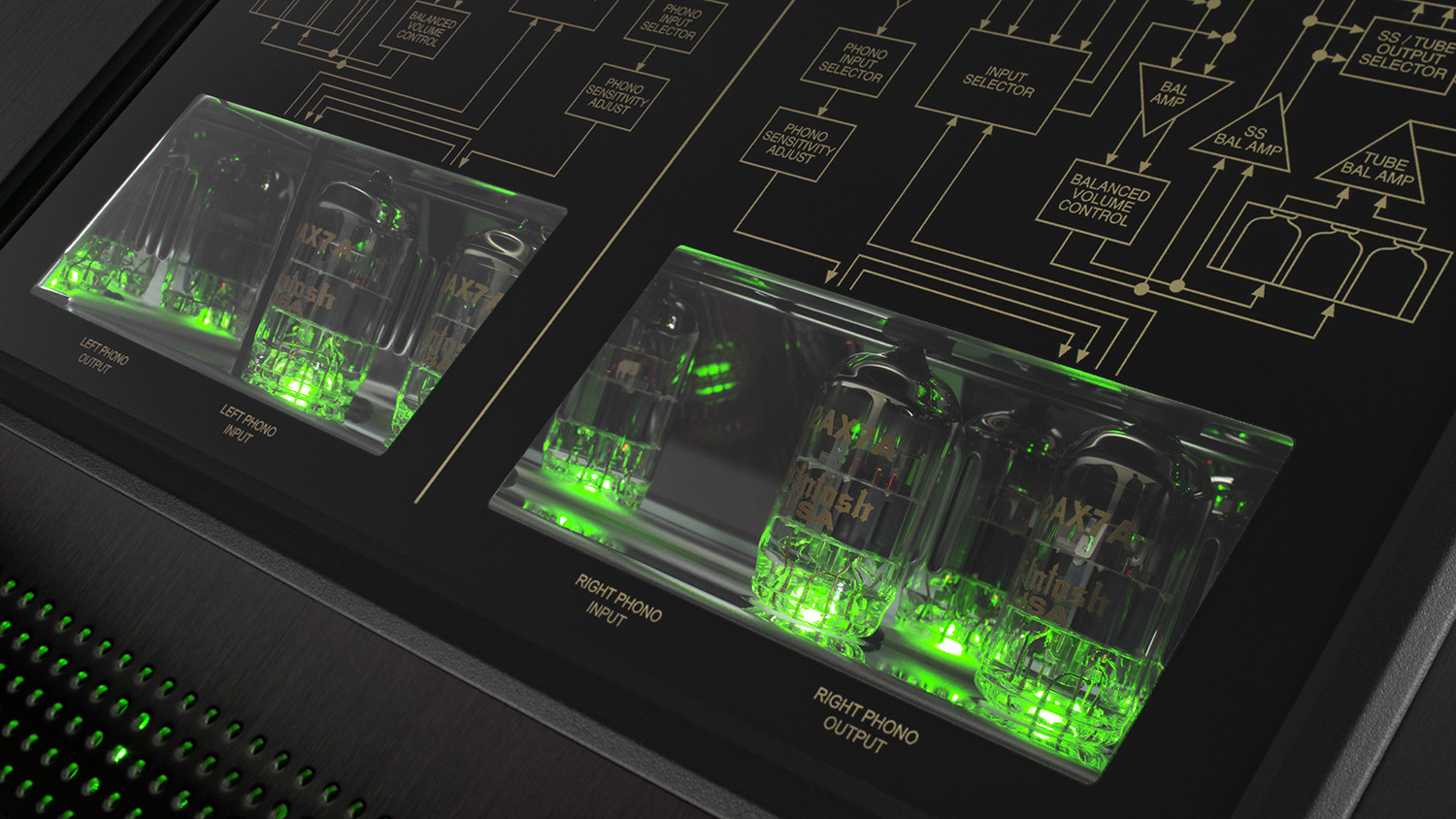
Sound quality
The intro to Livingston Taylor’s version of Stevie Wonder’s classic song Isn’t She Lovely (written to celebrate the arrival of his daughter Aisha) always brings a smile to our eyes, not only because the subject matter is close to our hearts, but also because of that beautifully delicate and understated acoustic guitar in the background of Taylor’s tasteful whistling of the melody.
Listening to Sonus Faber’s Il Cremonese ex3me floorstanders powered by this McIntosh duo made our smile grow all the wider, because the tonality of the acoustic was absolutely spot-on, while the sound of Taylor’s whistling was as if he were right in the room with us. Then, when the bongos chime-in in the second verse, the sense of realism just became even greater. The McIntosh duo made the sense of the room’s acoustic totally palpable… we could hear not only the air but also the warmth of the bongo echo, which was admirably soft rather than hard. The ‘quietness’ in the close-out to this track was complete, too, revealing that the McIntosh electronics had no background noise whatsoever.
Moving from male vocal to female vocal, we switched to the ravishingly gorgeous voice of Sara K singing Gypsy Eyes, as recorded on her album ‘Made in the Shade’. Her very slightly breathy vocals are the highlight of this track, but the sound of the backing singers is as good as it gets, and the McIntoshes balanced the lead against the backing perfectly. The scat lines ‘oh, woe…’ integrated better than we’ve heard before, so when Sara K echoes the backing singers – and vice versa – it all made perfect musical sense.
Sticking with female vocals but revving up the pace, we next auditioned Ana Caram, as heard on her classic album ‘Maracanã’ (which we confess we often refer to as “Macarena” when recommending it to friends, not only for the joyous, playful music contained on it but also the sound quality). Listen to Maybe, for example, and you can appreciate the professionalism of her singing. Perfect diction, perfect pitching – and all done so effortlessly she makes it seem easy, which we can assure you it isn’t. Rather annoyingly, Caram is also a superb guitarist, flautist, conductor and composer, so it’s little surprise that she was mentored by none other than Antonio Carlos Jobim or that her own unique style blends Jobim’s bossa nova style with jazz.
Once again, the McIntosh duo (and the Il Cremonese Ex3me) delivered exemplary sound quality, for which you should listen particularly to the sound of the oboe, as impeccably styled by Al Hunt, who’s more usually found playing with The New York Saxophone Quartet. He also plays flutes, clarinet and English horn on various tracks of this album, but it’s his oboe sound we found most impressive. And if you’re good at word puzzles, you have probably already realised (unlike us!) that this album’s title is actually an anagram of Ana Caram. (For the record, it’s also the name of the biggest football stadium in Caram’s birth country of Brazil.)
We checked out the McIntosh’s bass delivery with the fantastic walking bass sound on Queen’s Crazy Little Thing Called Love and found it to be precise, depthy, completely free from distortion, and with no overhang at all, plus there was a realism to the delivery that still continues to elude solid-state amplifiers, despite the leaps and bounds made in technology. No doubt this is one of the reasons McIntosh continues to build valve amplifiers. But don’t listen only to the perfect sound of the bass: also admire the crispness and snap of the percussion, and the authenticity of the hand-claps, which the McIntoshes revealed more clearly than we have ever heard previously. Notice too, that the high frequencies are balanced beautifully against the lows, particularly the shimmer of the cymbals.
Our bass evaluation continued when listening to Hector Berloiz’s Symphony Fantastique, which American conductor Leonard Bernstein once famously described as “the first musical expedition into psychedelia because of its hallucinatory and dream-like nature.” We suspect Bernstein’s comment might well have been influenced by the rumour that Berlioz composed at least a portion of it under the influence of opium, an idea that was possibly influenced by the success of Samuel Taylor Coleridge’s poem ‘Kubla Khan’, the idea behind which the poet claimed came as a result of a dream influenced by opiates.
As you’d expect, Symphony Fantastique uses the full force of the orchestra to grand effect, particularly the tympani, but also adds in instruments you might not expect, such as a ship’s bell in the final movement. As the occasion seemed to demand it, we wound up the volume as high as we dared at those points in the score where the orchestra is in full flight to see if we could approach the power reserves of the McIntosh MC3500 MkII pair.
After numerous attempts at approaching maximum output levels, it quickly became clear that we’d never even get close to approaching them, evidenced both by our ears and the movements of the needles on the front panel output meters. The result of these fruitless attempts is that we can confidently state that in a home hi-fi situation, even when using inefficient and/or difficult-to-drive loudspeakers, you will never need to avail yourself of the full power output of which these amplifiers are capable.
Given the duality of the nature of the pre-amp stage (it being switchable between valve and solid-state paths, and the fact that in a modern world of solid-state amplifiers with either linear or Class D output stages of one type or another, that of the McIntosh MC3500 MkII is unashamedly old-school), we knew that many readers, not content with our rather lengthy and detailed descriptions of this system’s sonic performance with a variety of different types of music, would instead want some kind of short version of our opinion and therefore ask the inevitable audiophile question: “Yes, but how does it sound?”
However, just as the designers of the supercomputer Deep Thought (see Douglas Adams’ novel The Hitchhiker’s Guide to the Galaxy) were dissatisfied with its answer to their ‘Ultimate’ question (it being “the meaning of Life, the Universe and Everything”), those readers wanting such a short version might be dissatisfied with our answer, which would be ‘natural’. This McIntosh system simply sounds natural. Listen to it and you’ll discover that you are listening to music – pure, simple, unadulterated music. It’s not ‘bright’ or ‘hard’ or ‘soft’ or ‘warm’ or ‘euphonic’… it’s just as you’d expect music to sound: natural.
Verdict
All told, we thoroughly enjoyed our all-too-brief sojourn with these latest additions to McIntosh’s burgeoning stable of audio offerings. We can unhesitatingly recommend them to anyone who is desirous of owning an all-analogue audio amplification system that will bring not only them but also their children and, we have no doubt at all, their grandchildren, a sense of pride in the privilege of being able to own such products – and not only every time they look in their general direction but most especially every single time they listen to it… no matter what type of music they are listening to, now or in the very far distant future.
Australian Hi-Fi is one of What Hi-Fi?’s sister titles from Down Under and Australia’s longest-running and most successful hi-fi magazines, having been in continuous publication since 1969. Now edited by What Hi-Fi?'s Becky Roberts, every issue is packed with authoritative reviews of hi-fi equipment ranging from portables to state-of-the-art audiophile systems (and everything in between), information on new product launches, and ‘how-to’ articles to help you get the best quality sound for your home.
Click here for more information about Australian Hi-Fi, including links to buy individual digital editions and details on how best to subscribe.
